Last Chance to Catch NYC's Holiday Notalgia Train
We met the voices of the NYC subway on our nostalgia ride this weekend!


Across New York City, New Yorkers have joined together in support of Ukraine, many attending rallies or donating to organizations providing aid to the over one million people who fled the country. The city has about 150,000 Ukrainian residents, many concentrated around the East Village’s “Little Ukraine” and southern Brooklyn’s “Little Odessa.” Though many Ukrainian-owned businesses have closed over the years, a handful of restaurants, shops, and cultural centers are still open, many of whom have led efforts in solidarity with the country. Here is our guide to 15 Ukrainian places to support, as well as a number of Ukrainian churches giving support.
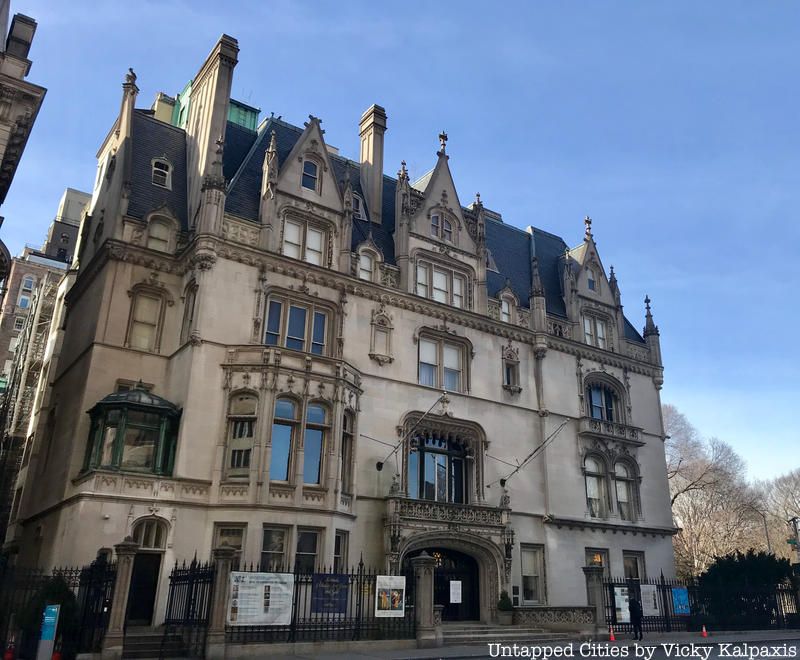
The Ukrainian Institute of America is a nonprofit dedicated to promoting Ukrainian and Ukrainian-American culture. The institute features art exhibits, readings, lectures, and film screenings to shine a light on the artistic and literary contributions of leading Ukrainian creatives. Currently, the institute has on display the art of Alexander Archipenko, Vasyl Diadyniuk, and Zhanna Kadyrova, and it will soon host a concert featuring Ukrainian composers Hanna Havrylets and Oleksandr Bilash. The institute is one of the Ukrainian places in NYC that has been instrumental in leading efforts to take action and #StandWithUkraine.
The institute is located in the Harry F. Sinclair House, a Gilded Age mansion at the southeast corner of East 79th Street and Fifth Avenue. The mansion was built between 1897 and 1899 and is named for the founder of Sinclair Oil, who was later implicated in the Teapot Dome scandal. Later, descendants of Peter Stuyvesant lived in the home, which was designed in the French Renaissance style by C. P. H. Gilbert. Many of Gilbert’s buildings still stand today, including the Felix M. Warburg House, which hosts the Jewish Museum. The home was sold in 1955 to the Ukrainian Institute of America, founded by Ukrainian businessman William Dzus.
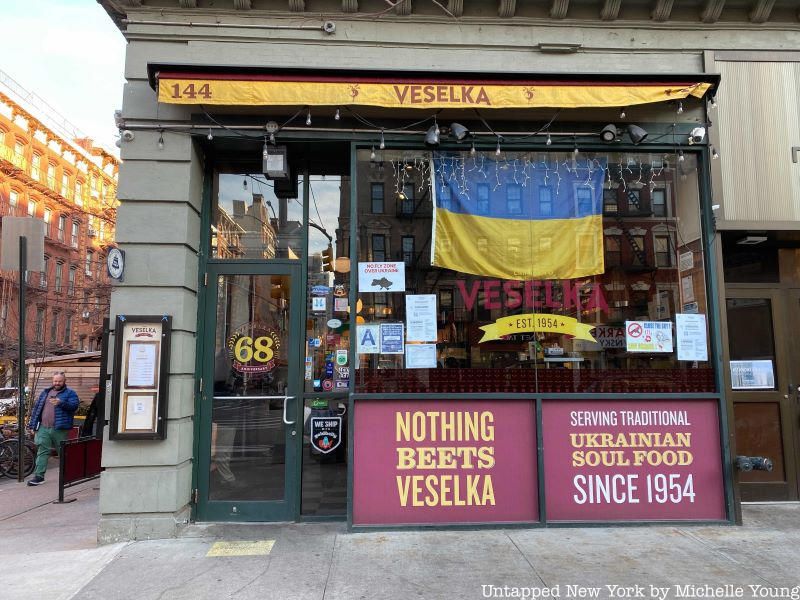
Veselka, whose name translates to “rainbow,” is one of the best-known Ukrainian places in New York City, located in the East Village. Veselka has been serving traditional Ukrainian food since 1954, later expanding in 1966 on East Ninth Street. Veselka transitioned to 24 hours, 7 days a week service in 1990, expanding into its current space in 1996, nearly doubling in size. Veselka now has an East Village location and one in Essex Market with a smaller menu.
Veselka is known for its homemade varenyky, or Ukrainian pierogis, which come in varieties such as meat, potato, cheese, arugula & goat cheese, sauerkraut & mushroom, and potato & mushroom. Diners flock from all over the country to try Ola’s veal goulash, chicken paprikash, stuffed cabbage, and the mixed Ukrainian grill with three types of pork sausage. As of this week, 100% of proceeds from borscht sales will go toward the Razom For Ukraine organization, and the restaurant is taking both monetary and non-monetary donations for Ukraine relief funds. The Bronx Brewery has partnered with Veselka in brewing a beer to benefit Ukraine.
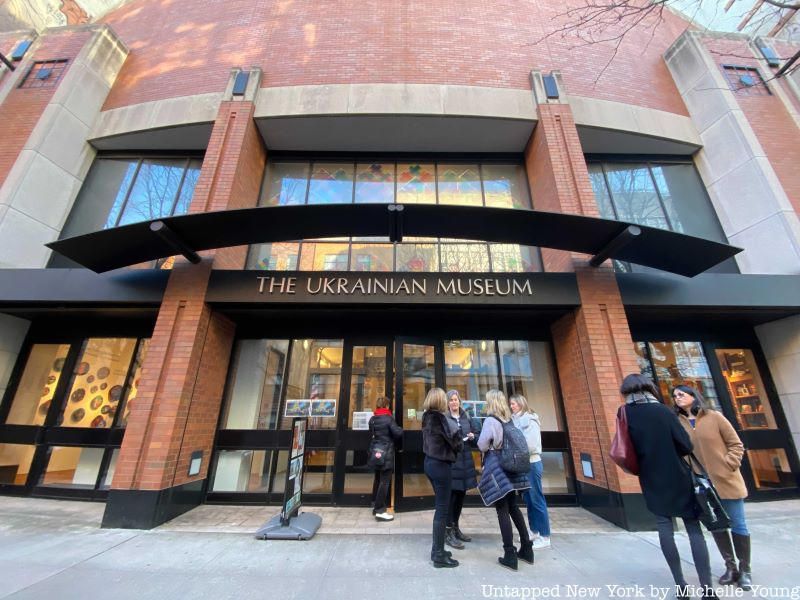
The Ukrainian Museum, located at 222 East 6th Street between Second Avenue and Cooper Square, is considered the largest American museum dedicated to Ukrainian culture and history. The East Village museum was founded in 1976 by the Ukrainian National Women’s League of America and was previously located at 203 Second Avenue. The firm Sawicki Tarella Architecture + Design led the new building’s design, largely funded by Ukrainian Americans.
The museum is known for its folk art, fine arts, and artifacts detailing Ukrainian immigration to the U.S. Among the museum’s folk art are ritual clothing, Ukrainian Easter eggs, metalwork, and traditional ceramics. Paintings and sculptures on display were created by some of Ukraine’s most accomplished artists, including Nikifor, Vasyl Hryhorovych Krychevsky, and Alexander Archipenko. Photographs, flyers, and letters detail the long journeys of thousands of Ukrainians to the U.S. through Ellis Island. Currently on display is The Impact of Modernity, In Bloom: Nature and Art, and Finding Sanctuary During the Pandemic. An Installation by Christina Saj. The museum has compiled a list of organizations accepting donations.
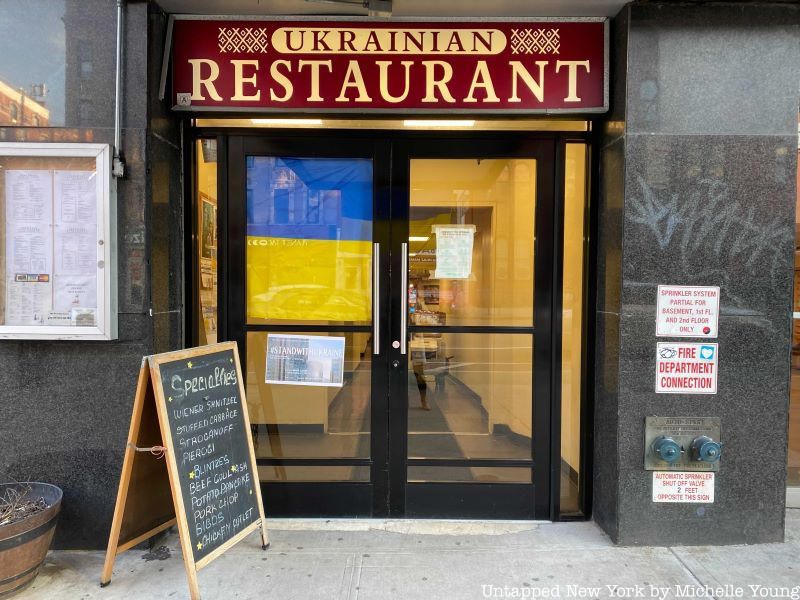
Ukrainian East Village Restaurant is located in the back of the Ukrainian National Home at 140-142 Second Avenue in the East Village. The building, which dates back to 1830, has hosted the Stuyvesant Casino as well as a YMCA location when the area was known as Little Germany. The film Taras Shevchenko, named for a 19th-century Ukrainian nationalist, featured a performance at the building by the band New Order. The roof and much of the facade were destroyed in a 1984 fire.
Ukrainian East Village Restaurant is one of the most traditional Ukrainian places in NYC, with decor including Ukrainian paintings, plates, and clothing. Dishes include herring in wine sauce, fruit blintzes, halusky dumplings with sauerkraut, and chicken Kiev. The restaurant is helping boost a fundraiser to send humanitarian aid to Ukraine via Facebook. They are also serving Ukrainian borscht to honor heroes in Ukraine.
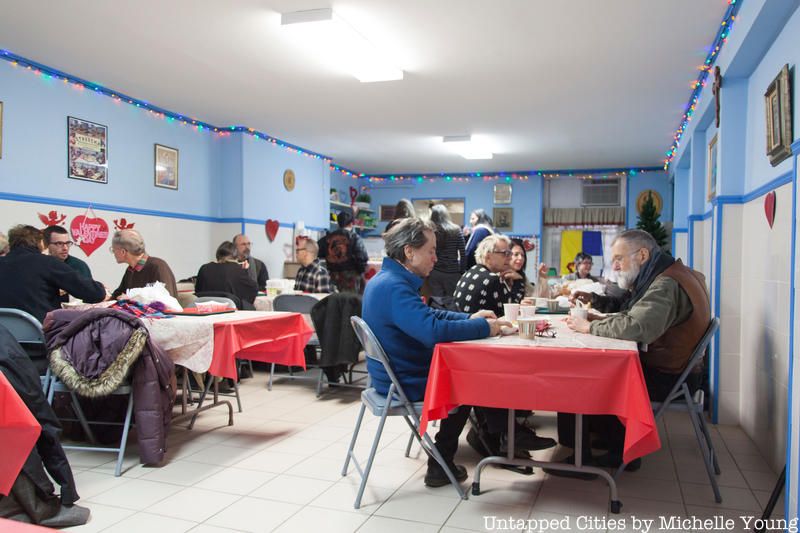
Streecha is one of the newer Ukrainian places to eat in New York, located on East 7th Street. The restaurant is just a small room with white tablecloths covered with images of pumpkins and leaves, walls covered with religious images and art, and some traditional Ukrainian cloth. A sign by the entrance reads “Stop Putin. Stop War. Help Ukraine.”
The menu is smaller but less expensive than Veselka’s, with classics such as borscht, varenyky, stuffed cabbage, sausage with cabbage, and a selection of baked goods. The basement-level restaurant serves up hundreds of varenyky a day, topped with caramelized onions and filled with potato. The restaurant lets volunteers help make the varenyky on Saturdays from 8 a.m. to 11 a.m. The restaurant has also been posting on its TikTok page in support of the Ukrainian Army.
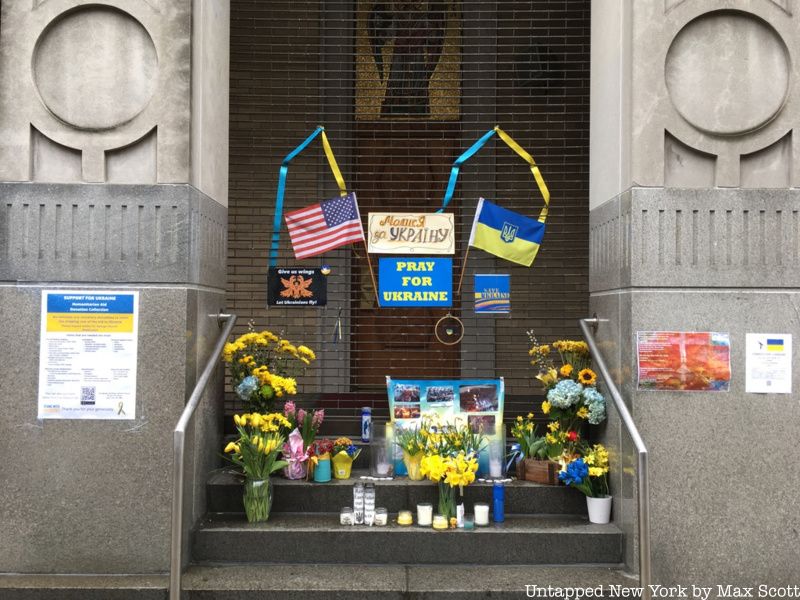
St. George Ukrainian Catholic Church is a Ukrainian Greek Catholic Church in the East Village. It is located right off Taras Shevchenko Place, right across from McSorley’s Old Ale House. St. Brigid’s Roman Catholic Church nearby was the first to have a Ukrainian language liturgy. St. George’s was founded over 100 years ago, occupying the Bowery Village Church, which earlier served the German immigrant community. The current Greek Revival building features an onion dome and was built in 1976 to 1978 with influences from Ukrainian Byzantine architecture. Principal artist with the Metropolitan Opera Andrij Dobriansky served as the church’s liturgical cantor for over 30 years.
Today, the church has set up a shrine on its steps, featuring flowers, candles, and personal notes. Passersby can leave a note or stop by to pay respect to those who lost their lives.
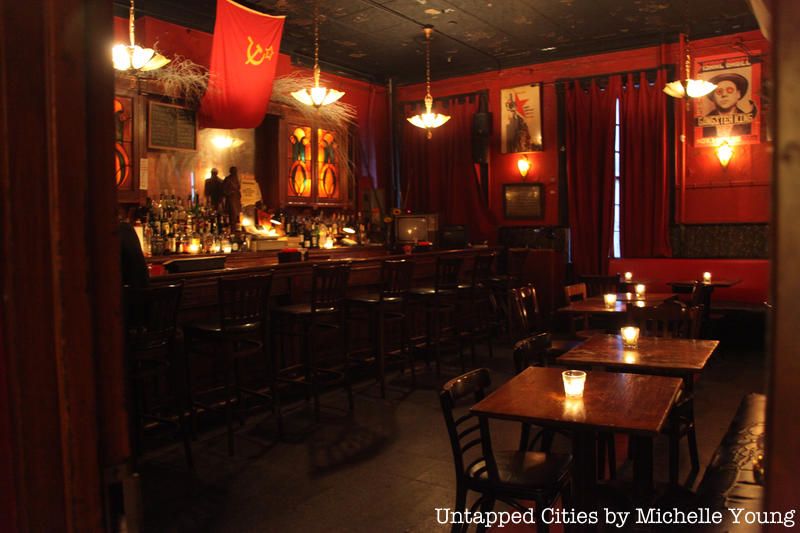
KGB Bar is a Soviet-era-themed East Village bar that opened in 1993, The building had previously been the site of Palm Casino, a speakeasy controlled by Lucky Luciano. Ukrainian Socialists met at the spot from 1948 to 1988 behind double-locked doors to avoid suspicion, calling it the Ukrainian Labor Home. The Ukrainian-American League would later control the basement. KGB Bar took over the space in 1993 and has become a literary institution, attracting leading authors and publishers to read and talk about their latest works.
KGB Bar has been rated among the top 10 dive bars in New York City for its cheap drinks and free admission. The bar hosts poetry nights, small concerts in its Red Room, and reading series. The bar has recently swapped its Russian alcohol for Ukrainian brands, selling the Ukrainian beer Obolon and swapping Russian vodka with Khor, Shevkoff, and Ukrainian Heritage. The bar will also host readings and music events to provide resources for Ukrainian aid.
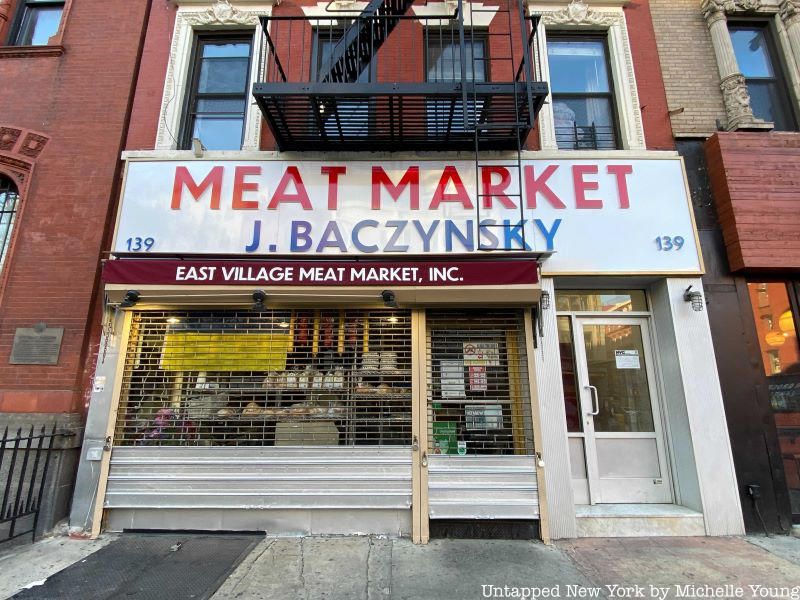
East Village Meat Market, also named for J. Baczynsky, is a butcher store founded in 1970. It is one of the last remaining Ukrainian butcher shops in New York. Julian Baczynsky opened the shop as part of a lifelong dream to own a business. The butcher features items like St. Louis ribs, Krakow kielbasa, kishka, kabanos (thin Polish sausages), and bochok (smoked pork belly). The shop also sells pierogis, blintzes, and mustard, staples of Ukrainian cuisine.
East Village Meat Market has been accepting donations on its website through Razom for Ukraine. It also posts frequently on Facebook in support of Ukraine, alongside many other East Village institutions.
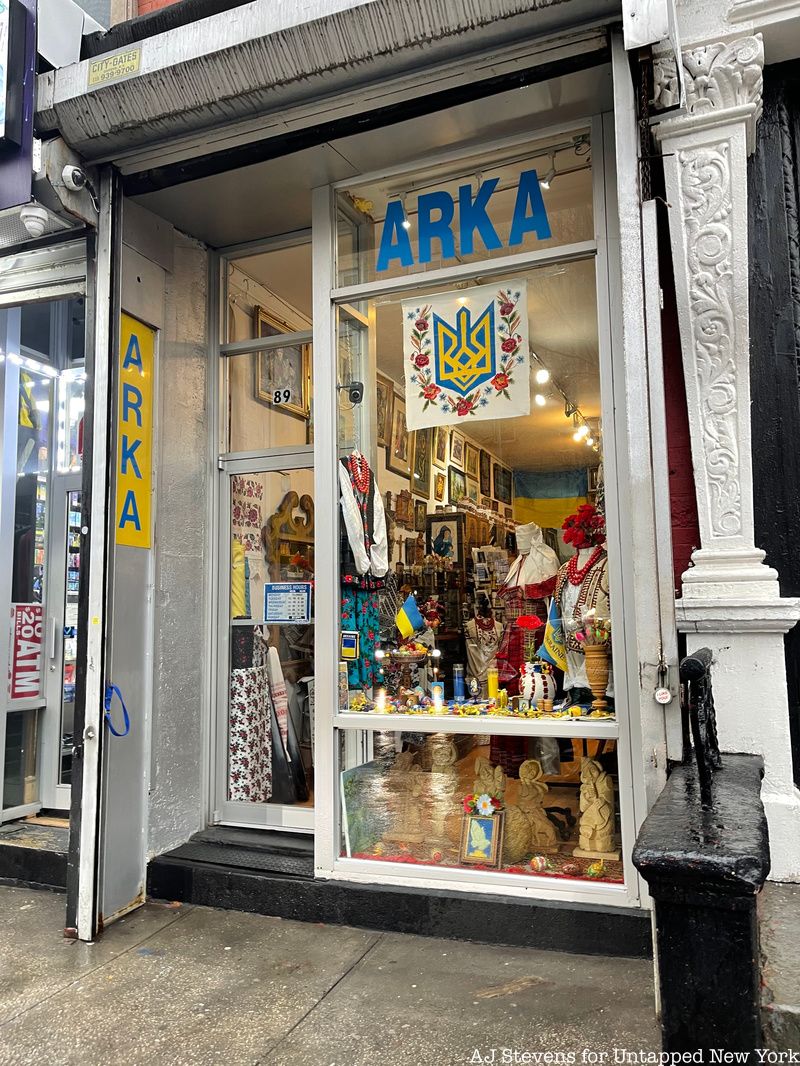
Opened in 1951, Arka Store is one of the last remaining Ukrainian places in Manhattan that sells Eastern European books, jewelry, antiques, woodwork, and traditional clothing. Among the store’s collection is an early 20th-century pair of costumes from the Hutzul region of the Carpathians and traditional clothing from regions like Borschiv and Bukovina, The store also features religious icons, pottery, glassware and dining sets, and Ukrainian cloth.
The store’s first owners were Roman Porytko and Jaroslav Pastushenko, two Ukrainian immigrants who settled in the East Village. The store also served as a cultural center for the community, a meeting place of sorts where shoppers could talk about the news or current affairs. The store has survived many waves of gentrification, and though business has been dwindling for years, owner Mykola Drobenko has been fighting to keep the store and Ukrainian heritage alive.
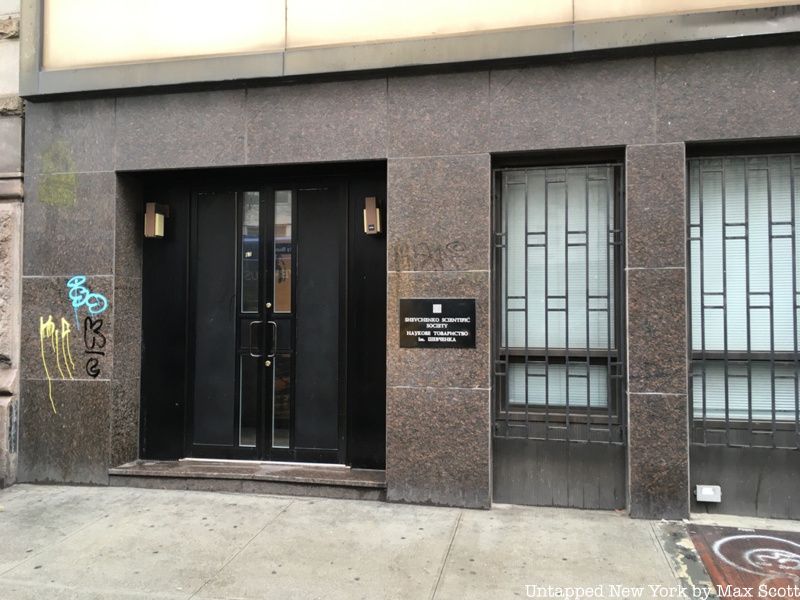
The Shevchenko Scientific Society is a Ukrainian scientific society founded in Lviv with a branch in Manhattan at 63 Fourth Avenue. The society, founded in 1873, promotes scholarly research and publication and takes its name from poet Taras Shevchenko.
The organization started off as promoting just Ukrainian literature, but it later shifted to research in three areas: history-philosophical, philological, and mathematically-medical-natural scientific. The society has a specialized library, an archives depository pertaining to Ukraine and its diaspora, and an art collection. The society at large is now publishing the third volume of Encyclopedia of the Ukrainian Diaspora.
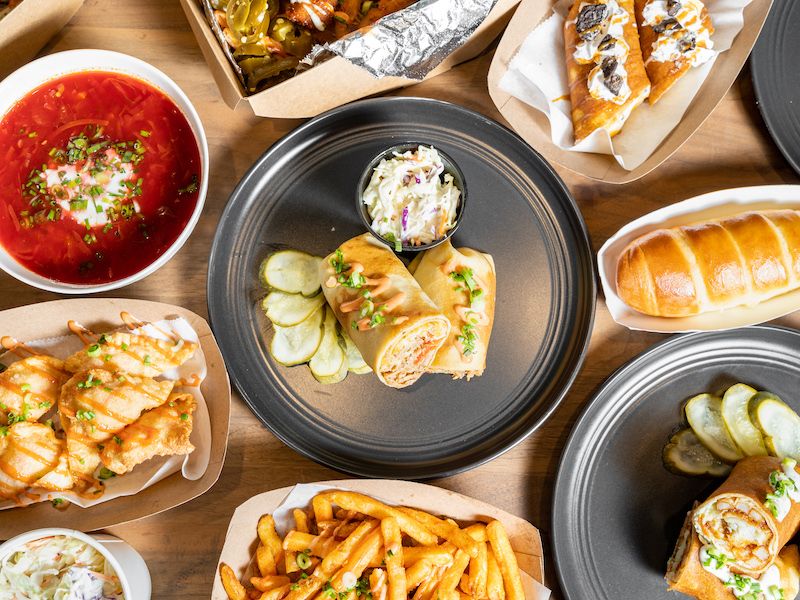
Blintz Box is one of the city’s newest Ukrainian places to eat with an American twist at the Turnstyle Underground Market by Columbus Circle. Blintz Box started out as “Taste of Ukraine,” appearing at food fairs in Long Island City, then Queens Night Market, then Urban Space markets. Their newest permanent location opened in December 2021.
Blintz Box specializes in both sweet and savory blintzes: sauteed steak, creamy mushrooms, and beer-battered cod on the savory side, and sweet cheese and peaches n cream on the sweet side. Savory blintz wraps pull from classic American fare, like their take on a Philadelphia cheesesteak. Vegan borscht appears alongside corn dogs and loaded fries as side dishes. The restaurant is accepting donations to UnitedHelpUkraine.org and ArmySOS.com.ua.
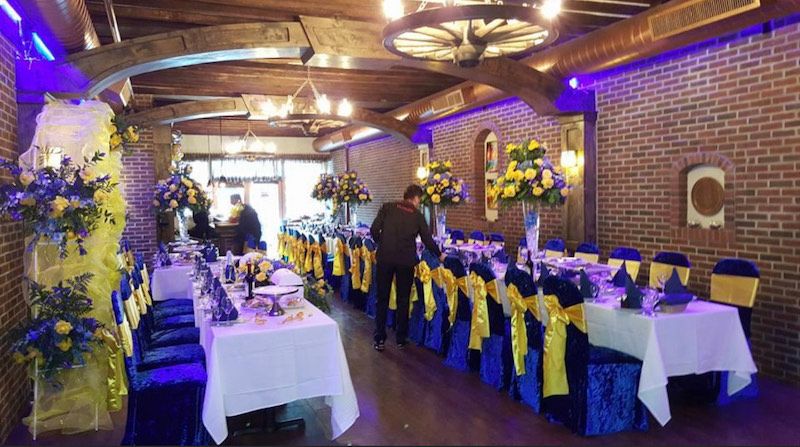
Rondel is a Ukrainian restaurant along Coney Island Avenue in Brooklyn. Though not as well known as the East Village’s Ukrainian places, Rondel is an intimate and elegant spot in southern Brooklyn, featuring a dark ambiance with exquisite light fixtures, lavish tables, and live music on weekends. The restaurant has been posting on Facebook encouraging diners to support Ukrainian people and soldiers through an Amazon link.
Rondel features a rather extensive menu that also pulls from other European cuisines, such as Georgian. Hot appetizers include potato pancakes, crepes with caviar, and foie gras, while cold appetizers range from Ukrainian salo (cured slabs of fastback) to pickled vegetables. There are over a dozen seafood entrees, including branzino and salmon in white sauce. For meat entrees, try poperechka (beef ribs with white beans), beef stew, or lamb shish kabob.
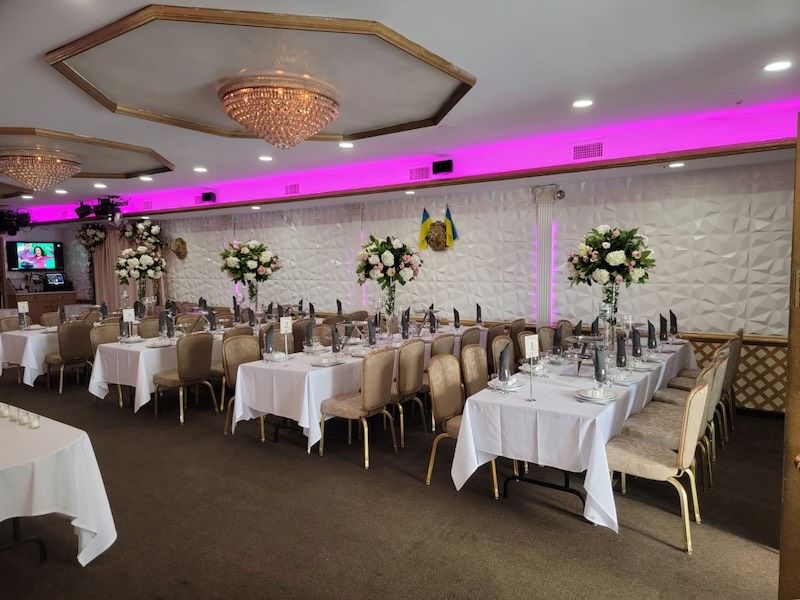
Golden Leo is another popular Brooklyn Ukrainian restaurant, located along Sheepshead Bay Road. It is under the same ownership as Rondel and is similarly elegant inside with white tables, black chairs, and beige-gold walls. Sheepshead Bay and nearby Brighton Beach have among the highest Ukrainian populations in New York City, many living here for decades after immigrating to escape religious persecution and the Holocaust. Though, the area called “Little Odessa” consists of mostly Russian stores today.
The menu is similar to Rondel, featuring cold starters like duck salad, radish salad, and cold-boiled pork. Veal cheeks are a popular entree, as well as pork hock in beer, bass filet in mustard sauce, and chicken tabaka.
Belka Deli in Bath Beach, Brooklyn, specializes in Eastern European fare, with an emphasis on Ukrainian and Russian products. The deli includes a full range of fresh meats, baked goods, and a wide range of produce. Food options range from borscht and blintzes to apricot and pineapple creme layer cakes to herring salad. The small deli also features dozens of cold salads sold by the pound.
One of the only Ukrainian places in Queens is Varenyk House, located in Ridgewood. The restaurant is owned by Stepan Rogulskyi, who immigrated to the U.S. in 2008. The small restaurant, which has been open for over a year, also features a small market with fresh meats, cold dishes, and produce.
Varenyk House features over 15 varieties of varenyky, including hard-to-find types like salty cheese, strawberry, and salmon. Main dishes include Ukrainian plov, cured pork knuckle, deruny (potato pancakes), and zapikanka (pork cutlet with potato and cheese). Starters include holodec (jellied pigs feet), Korean-style carrot salad, and meat croquettes. Many items are also available frozen, including their varenyky varieties. The restaurant has been active on social media in support of Ukraine.
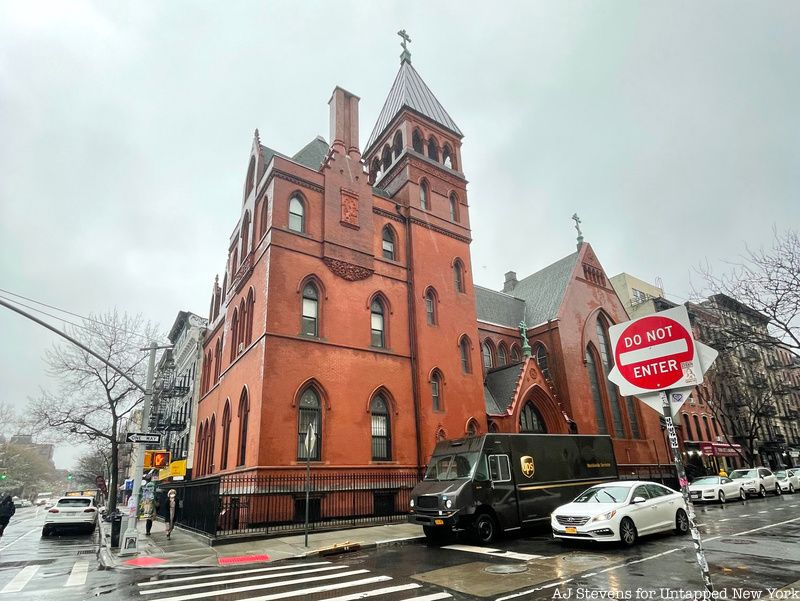
Throughout New York City, there are at least about a dozen Ukrainian churches, many concentrated in lower Manhattan. Most of these churches have been leading advocacy and donation efforts for Ukraine relief. All Saints Ukrainian Church, St. Nicholas Carpatho-Russian Orthodox Church, and St. Cyril’s Church are all located in the East Village, while Holy Trinity Ukrainian Orthodox Church is found on the outskirts of Chinatown. The Ukrainian Orthodox Cathedral of St. Volodymyr in Manhattan is located on the Upper West Side.
One of the only Ukrainian churches in Queens is the Holy Cross Ukrainian Catholic Church in Astoria, while St Mary’s Ukrainian Church is found in Ozone Park. South Slope is home to one of Brooklyn’s remaining Ukrainian churches, St. Nicholas Ukrainian Catholic Church, and there is one near Stapleton in Staten Island named Holy Trinity Ukrainian Catholic Church.
Next, check out the Top 10 Secrets of Brighton Beach, Home of Little Odessa.
Subscribe to our newsletter